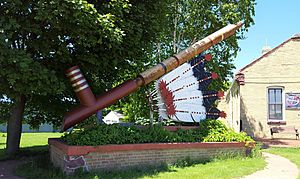World's Largest Peace Pipe facts for kids
The World's Largest Peace Pipe is a huge statue of a ceremonial pipe located in Pipestone, Minnesota, in the United States. It was inspired by a special dream shared by three spiritual people: one from the Lakota tribe and two from the Anishinaabe tribe. This giant pipe stands on the land of an old train station, the historic Rock Island Railroad depot. It's also very close to the Pipestone National Monument, a place where the Keepers of the Sacred Tradition of Pipemakers work. This spot is important because the nearby pipestone quarry is known as "the crossroads of the Indian world." For thousands of years, Native Americans have used the soft red stone from this quarry, called catlinite, to make sacred ceremonial pipes.
How the Idea Started
In the 1990s, something amazing happened. Three spiritual people from different Native American tribes had the same dream within two years!
Art Zimmiga, a Lakota man from Pine Ridge, South Dakota, had the first dream. He came to Pipestone to help start a group called the Keepers of the Sacred Tradition of Pipemakers. To wish them success, Zimmiga gave an eagle feather from his medicine bundle to Bud Johnston, who founded the group. For many Native people, an eagle feather helps connect them to the Creator.
On his way home, Zimmiga had a vision. He saw a giant pipe that could make smoke. In his vision, elders were giving gifts, and each time they did, smoke came out of the big pipe.
About six months later, a woman named Lisa Dietz, who was Anishinaabe, had a similar dream. She was part of a group that blessed the old train station building when the Keepers of the Sacred Tradition of Pipemakers started in 1996. She also had a dream of a huge pipe and encouraged people to build it.
A few months after that, Bud Johnston's oldest son, Bill, visited Pipestone from Spokane, Washington. While at the old train station, Bill also had a vision about building a giant peace pipe. He sent his father a drawing, and they talked about how to build it.
Bill imagined the pipe would be about 30 feet (9 m) long. He made a detailed drawing and figured out it could be made from steel well casing. The main part would be 12 inches (30 cm) wide, and the bowl and stem would fit together at seven or eight inches (18 or 20 cm).
Bill bought the steel, and his father, Bud, flew to Spokane to start working on the sculpture. Bud asked his youngest son, John, who was a very skilled welder, to help create the pipe. They designed it as a "four winds" pipe. This means it has four rings welded onto the bowl. These rings honor the four directions from which Native people have traveled to Pipestone.
Putting the Pipe in Place
Once the pipe was finished, finding a place for it was tricky. The city of Pipestone was not sure about putting the pipe on the historic Rock Island Depot property. After a lot of discussion, the Historic Preservation Committee finally said yes. They agreed as long as the pipe sat on a base made of cream-colored brick (to match the train station) and red quartzite, surrounded by flowers. The Keepers of the Sacred Tradition of Pipemakers bought the train station building and the land next to it in January 1997.
Getting the pipe from Spokane to Pipestone was another challenge. Mike Ziebarth arranged for a truck driver, who usually delivered Bayliner boats, to bring it to Minnesota for just the cost of gas.
The pipe arrived in Pipestone in January 1999. John Johnston suggested adding feathers to the sculpture. In Native American tradition, feathers are believed to help prayers reach the Creator faster. The feathers were made and attached to the sculpture during an annual pow wow the following August. A local artist painted the pipe sculpture. Below the pipe, there is a piece of red quartzite with a poem by Rona Johnston engraved on it. The poem honors all Native people who have traveled to Pipestone.
How People See It
The big pipe was featured in the May 2008 issue of Reader's Digest magazine. People from all over the world come to visit the quarries and take pictures in front of the world’s largest peace pipe.
 This article incorporates text from MNopedia, which is licensed under the Creative Commons Attribution-ShareAlike 3.0 Unported License.
This article incorporates text from MNopedia, which is licensed under the Creative Commons Attribution-ShareAlike 3.0 Unported License.


